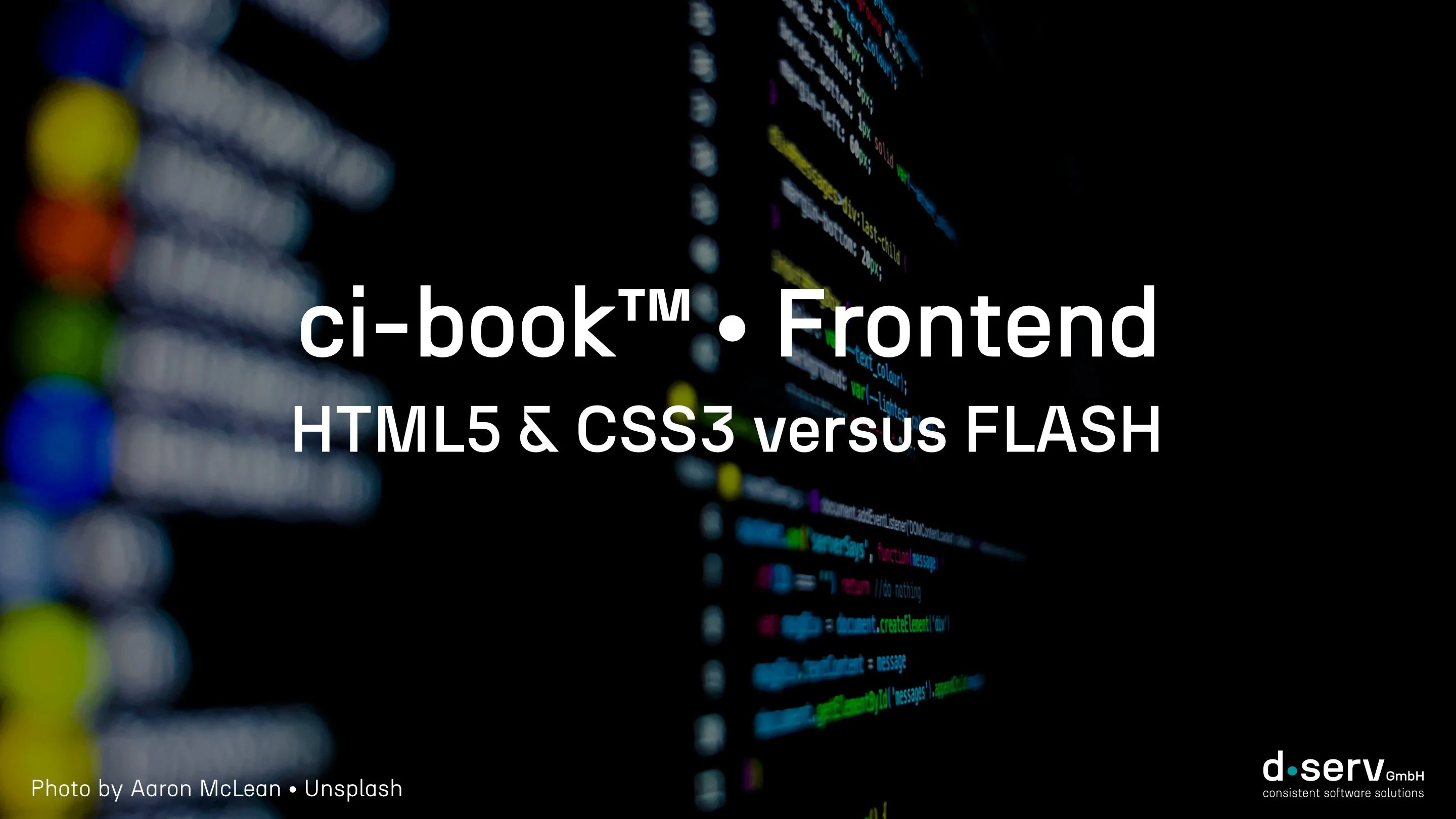ci-book™ • Frontend
2020-05-12
The reasons for using the Adobe™ Flash Player
For the acceptance and successful use of Web-To-Print and Web-To-Publish solutions, it was crucial for d-serv GmbH at the beginning of the development of ci-book™ not to implement form-based editors, but to offer familiar editing options and user interfaces from other software applications in so-called WYSIWYG mode. At the same time, fonts should be displayed on the screen as faithfully as possible and the PDF print files to be generated should not differ from the edited documents in the web browser. However, the HTML and CSS versions required for this were far from being standardised by all browsers. For these reasons, d-serv GmbH decided to use Adobe™ Flash Player, which was able to fulfil the desired requirements and enable a consistent user interface across different browser variants and versions. For a long time, the Adobe™ Flash Player could not be replaced satisfactorily or across the board.
The increasing support of HTML 5 and CSS 3
In spring 2010, Steve Jobs, then CEO of Apple, announced that the Adobe™ Flash Player would no longer be supported by Apple's operating systems, initially for smartphones and later also for tablets and desktops. According to his reasoning, the Adobe™ Flash Player is a software solution from the PC era that should be replaced by new web standards such as HTML 5 and CSS 3. This reasoning was not entirely unselfish, as it was possible to replace the well-established "apps" with the help of numerous Flash applications that were already mature at the time. This in turn would have meant that users of Apple's hardware would not have to rely solely on Apple's App Store. A year later, Google followed suit by announcing that it would also stop supporting Adobe™ Flash Player from Android 4.0 and added in 2017 that this would also apply to its Chrome web browser. (Google's) Android currently dominates the entire mobile operating system market with 87% and (Apple's) iOS with 13%.
The end for the Adobe™ Flash Player
The company Adobe, which had profited from the use of its Flash development environments for a good decade, was confronted by such statements and the enormous spread of mobile devices with the need to replace its proprietary technology with open web standards and promote alternative solutions. Current cloud applications from Adobe now rely on open formats themselves in order to run on various end devices. The official announcement by Adobe in summer 2017 that support for Flash applications and the further development of Adobe™ Flash Player would be completely discontinued at the end of 2020 increased the need to develop alternative solutions in the web-to-publish environment.
The result of progressive development
As a result of the aforementioned announcements and the now widespread use of browsers that support HTML 5 and CSS 3, d-serv GmbH was able to pursue the requirements for a web-to-publish solution described at the beginning and push ahead with its considerations for new applications and the overall product development of ci-book™. The first prototypes were tested in summer 2018, the first installations in spring 2019 and the changeover was completed in mid-2020. The applications based on Adobe™ Flash Player have been completely replaced by new applications based purely on HTML 5 and CSS 3.
The requirements for using ci-book™
For smooth operation, d-serv GmbH recommends the use of up-to-date web browsers based on the Blink engine (Google Chrome and Chromium-based browsers such as Opera and, in future, Microsoft Edge) or the Gecko engine (Mozilla Firefox) or the WebKit engine (Apple Safari). This list of web browsers and the associated engines, which are responsible for "rendering", i.e. the visual representation of the text-based HTML source code, gives an idea of the complexity behind the development of the web-based ci-book™ platform. ci-book™ continuously utilises the performance capabilities of current browser generations and has provided a web-to-publish solution without the use of Adobe™ Flash Player since 2020.
Sources on the web
[German language]
- Spiegel Online, Meldung zum offenen Brief von Steve Jobs: https://www.spiegel.de/netzwelt/gadgets/offener-brief-steve-jobs-prophezeit-das-ende-von-adobes-flash-player-a-692162.html
- Ankündigung von Google: https://www.blog.google/products/chrome/saying-goodbye-flash-chrome/
- Ankündigung von Adobe: https://theblog.adobe.com/adobe-flash-update/
- Heise Online, Meldung zur Ankündigung von Adobe: https://www.heise.de/newsticker/meldung/Adobe-verabschiedet-sich-von-Flash-2020-ist-Schluss-3783264.html
- Statista, Marktanteile der Betriebssysteme für Smartphones: https://de.statista.com/statistik/daten/studie/182363/umfrage/prognostizierte-marktanteile-bei-smartphone-betriebssystemen/